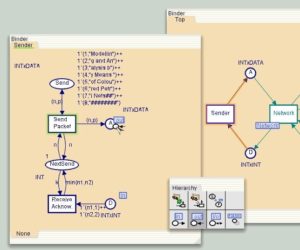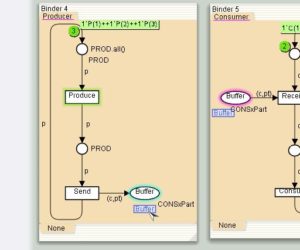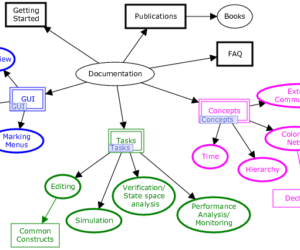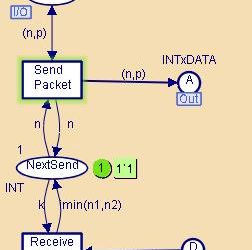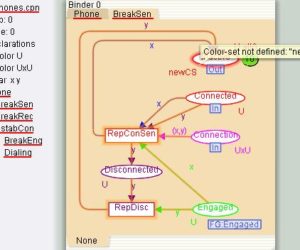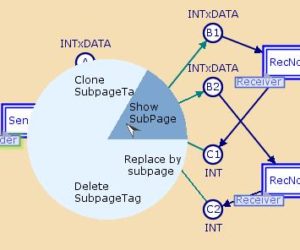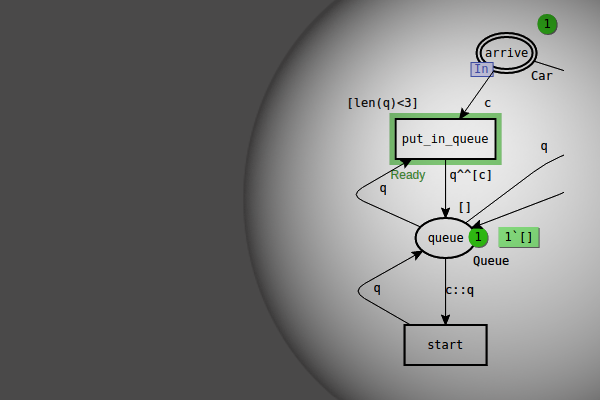When creating a hierarchical net “bottom-up”, you start by creating separate pages. In contrast to top-down development, this approach involves creating the most detailed parts of the net first. Later, existing pages are set as subpages for substitution transitions. Read more about how to edit the net and how to create a new page. The example below is based on the Hierarchical protocol example. In […]
Fusion places
CPN Hierarchy supports a method for defining sets of places so that anything that happens to each place in a set also happens to all the other places in the set. The places are then functionally identical. Such places are called fusion places, and a set of fusion places is a fusion set. Fusion adds nothing fundamentally new. If all the members of a fusion […]
Limitations
Errors during syntax check Errors can occur if any of the Hierarchy tools are applied while portions of a net are being syntax checked. It is highly recommended that you do not apply hierarchy tools while there are any yellow highlights on places, arcs, transitions, pages, or net names. Similar problems can occur if hierarchical constructions are cloned during syntax checking. Therefore, it is highly […]
Redo/Undo
Many of the operations that change the hierarchical structure of a CPN can easily be undone or redone using the Redo tool and Undo tool. For example, if the Delete element tool is used to delete a subpage tag, then the connection between a substitution transition and a subpage is broken, port/socket assignments are removed, and instances of the subpages are removed. (More information is […]
Hierarchy tags
Hierarchy tags are small blue tags, e.g. that are associated with some places and transitions in hierarchical CPNs. There are three kinds of hierarchy tags: Subpage tags Port-type tags Fusion-set tags Hierarchical constructs can be deleted or modified by deleting hierarchy tags. Read more about Removing hierarchical constructs. Subpage tags Subpage tags are associated with substitution transitions. The text in a subpage tag is the […]
Inscriptions in hierarchical nets
There are some differences between inscriptions in hierarchical nets and inscriptions in non-hierarchical nets. For example, there are differences in the semantic meaning of some inscriptions. Furthermore, changing some kinds of inscriptions has additional consequences in hierarchical nets. These differences are described below. Ports and sockets Color set inscription A port/socket pair must always have the same color set inscription. An error will occur if […]
Removing hierarchical constructs
Hierarchical constructs can be removed by using the Delete element tool. The Delete element tool can be used to Remove a place from a fusion set, Remove a fusion set, Remove port type, Remove a reference to a subpage, and Delete an entire subpage. A substitution transition can also be replaced by its subpage using the Replace by subpage tool. For more details removing hierarchical […]
Substitution transitions
Creating large, intricate nets can be a cumbersome task. But similar to modular programming, the construction of CPNs can be broken into smaller pieces by utilizing the facilities within CPN Tools for creating substitution transitions. Conceptually, nets with substitution transitions are nets with multiple layers of detail – you can have a somewhat simplified net that gives a broad overview of the system you are […]
Top-down development
When creating a hierarchical net “top-down”, you start by creating the page that shows the overview of the subpages and how they are connected. See the Edit the net page on how to create the net structure. The example below is based on the Hierarchical Protocol example. In this example, the transitions Sender and Network on page Top are very abstract representations of the Sender […]
